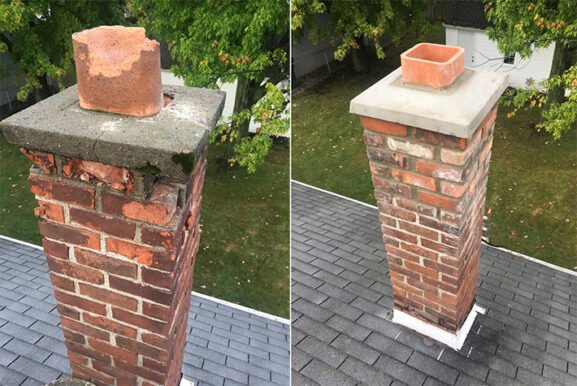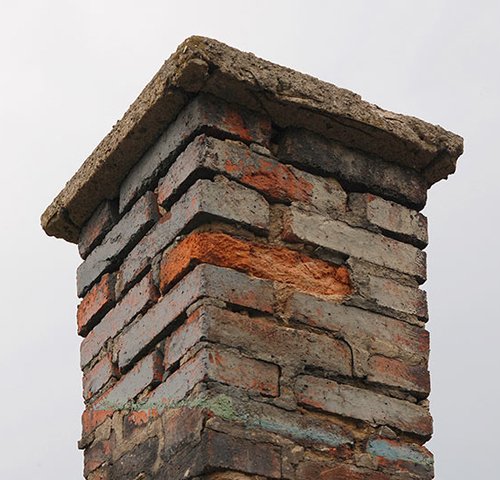Understanding Chimney Flue Repair Cost and What Homeowners Should Expect
Key Takeaways
- Chimney flue repair costs typically range from $300 to $3,500 depending on the extent of damage and repair type
- Flue liner material and chimney height are key factors that influence pricing
- Ignoring flue issues can lead to fire hazards and carbon monoxide exposure
- Getting a professional inspection is the safest way to determine accurate repair costs
Why Chimney Flue Damage Should Never Be Ignored
The chimney flue is a critical part of your fireplace system. It’s the passage inside the chimney that directs smoke and combustion gases safely out of your home. When the flue becomes damaged, it can allow toxic gases like carbon monoxide to leak indoors or create fire hazards due to heat exposure in areas not designed for it.
Homeowners often delay chimney flue repairs because the damage isn’t always visible. But if you’ve noticed smoke backing up into the room, strong odors when burning wood, or visible cracks in your chimney liner, these may all be signs of a flue that needs attention. Addressing these issues early can prevent larger and more costly structural damage.
What Influences Chimney Flue Repair Costs
The cost of repairing a chimney flue varies widely depending on several important factors. Below are the main elements that can affect the final bill:
Type of Flue Liner
The material used in your chimney liner has a direct impact on the repair cost. There are three common types:
- Clay tile liners are standard in older homes and tend to crack over time. Replacing damaged tiles or relining with a different material can cost between $1,000 and $2,500.
- Metal liners, especially stainless steel, are more durable and often used as replacements. Depending on chimney height and diameter, repairs or replacements range from $900 to $3,500.
- Cast-in-place liners, which involve pouring a cement-like material inside the flue, can provide excellent sealing and insulation, but come at a higher cost—typically between $2,000 and $5,000.
Extent of Damage
Minor cracks or gaps can sometimes be sealed or patched for a few hundred dollars. But if the liner is severely deteriorated or if sections have collapsed, the repair may involve removing and fully replacing it. Labor, scaffolding, and additional structural work can increase costs significantly.
Chimney Height and Accessibility
Taller chimneys require more materials and safety equipment, which naturally raises labor costs. Accessibility issues—such as a steep roof pitch or an awkward chimney location—can also increase the time and resources needed for the repair.
Local Building Codes and Permits
Depending on your location, you may need permits or inspections before work can begin. Complying with local building codes ensures your chimney is safe and up to standard but may slightly increase overall repair costs. It’s important to hire a licensed chimney technician familiar with your municipality’s requirements.
Signs That Your Chimney Flue May Need Repair
Many homeowners are unaware of early warning signs that point to flue damage. Recognizing these signs can help prevent emergencies and reduce the cost of repair down the road. Keep an eye out for:
- Smoke entering your home during use
- Strong creosote odor from the fireplace
- Crumbling pieces of tile or metal falling into the fireplace
- Staining on the chimney exterior
- A decrease in heating efficiency
If you notice any of these symptoms, it’s best to schedule a chimney inspection right away. Certified chimney sweeps have tools like cameras that can inspect the interior of the flue and spot damage not visible to the naked eye.
Professional vs DIY Repair Considerations
Some homeowners consider DIY repair options to save money. While patching minor cracks might seem doable, working on a chimney flue without proper training and equipment is risky. Improper repairs can lead to poor ventilation, chimney fires, or exposure to harmful gases. Additionally, most building codes require flue repairs to meet strict safety standards that are difficult to ensure without professional expertise.
Hiring a certified chimney specialist is not just a matter of convenience—it’s about safety. These professionals are trained to assess damage accurately, recommend suitable materials, and perform repairs that comply with fire codes and manufacturer warranties.
When Relining the Flue Becomes Necessary
In some cases, simple patchwork won’t be enough. Chimney relining is often the best long-term solution when:
- The original liner is badly cracked or missing sections
- You’re switching to a different fuel type, such as converting from wood to gas
- You’re installing a new fireplace or heating appliance that requires a different flue diameter
Relining costs vary by material and labor, but the result is a safer, more efficient chimney system that can last for decades with proper care. For instance, stainless steel liners—while a higher upfront investment—are corrosion-resistant and come with long-term warranties, making them a smart choice for many homes.
You can learn more about liner standards and safety recommendations from organizations like the Chimney Safety Institute of America (CSIA).
Understanding Cost Breakdown for Better Planning
Here’s a general estimate of what homeowners might expect for different chimney flue repair needs:
| Type of Repair | Estimated Cost Range |
| Sealing minor cracks | $300 – $600 |
| Repairing clay tiles | $1,000 – $2,500 |
| Installing metal liner | $900 – $3,500 |
| Cast-in-place relining | $2,000 – $5,000 |
| Full chimney relining | $2,500 – $7,000+ |
It’s a good idea to get multiple quotes from reputable contractors in your area. Always confirm whether the estimate includes labor, materials, inspections, and clean-up.
How to Minimize Future Repair Costs
Preventive maintenance is the best way to avoid unexpected repair bills. Here are a few best practices homeowners can follow:
- Schedule annual chimney inspections and cleanings
- Burn only seasoned hardwood to reduce creosote buildup
- Install a chimney cap to keep moisture and debris out
- Watch for signs of smoke leakage or unusual smells
- Keep records of past repairs and inspections for future reference
Routine care can extend the life of your flue liner and reduce the chances of needing a full reline or major repair. While inspections and cleanings come with a cost, they’re far less expensive than emergency repairs caused by neglect.
Final Thoughts on Protecting Your Chimney System
Chimney flue repairs aren’t something to overlook or delay. A damaged flue can lead to serious safety issues and costly home damage if not addressed promptly. Understanding what affects chimney flue repair cost, recognizing signs of trouble, and working with a qualified professional can help ensure your chimney stays safe and functional year-round.
By investing in preventive care and addressing minor problems before they escalate, homeowners can manage costs and avoid larger, more disruptive repairs in the future.

